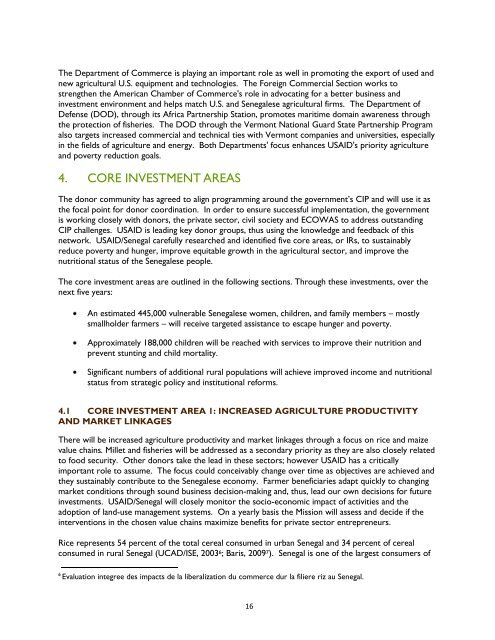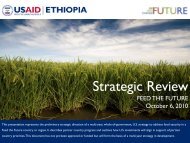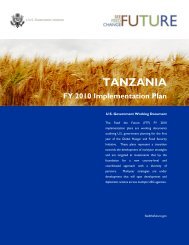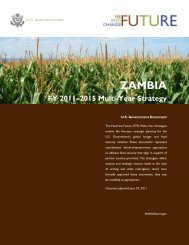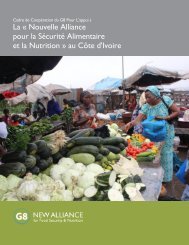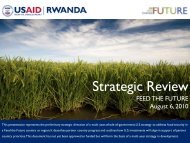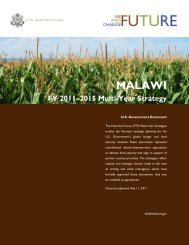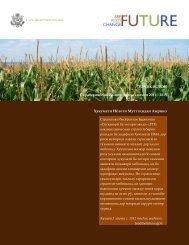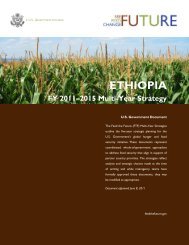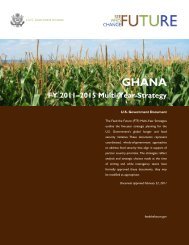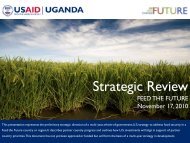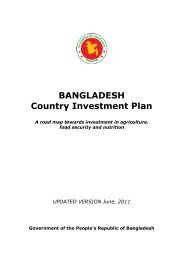Feed the Future Multi-Year Strategy, Senegal, Public
Feed the Future Multi-Year Strategy, Senegal, Public
Feed the Future Multi-Year Strategy, Senegal, Public
You also want an ePaper? Increase the reach of your titles
YUMPU automatically turns print PDFs into web optimized ePapers that Google loves.
The Department of Commerce is playing an important role as well in promoting <strong>the</strong> export of used and<br />
new agricultural U.S. equipment and technologies. The Foreign Commercial Section works to<br />
streng<strong>the</strong>n <strong>the</strong> American Chamber of Commerce's role in advocating for a better business and<br />
investment environment and helps match U.S. and <strong>Senegal</strong>ese agricultural firms. The Department of<br />
Defense (DOD), through its Africa Partnership Station, promotes maritime domain awareness through<br />
<strong>the</strong> protection of fisheries. The DOD through <strong>the</strong> Vermont National Guard State Partnership Program<br />
also targets increased commercial and technical ties with Vermont companies and universities, especially<br />
in <strong>the</strong> fields of agriculture and energy. Both Departments' focus enhances USAID's priority agriculture<br />
and poverty reduction goals.<br />
4. CORE INVESTMENT AREAS<br />
The donor community has agreed to align programming around <strong>the</strong> government’s CIP and will use it as<br />
<strong>the</strong> focal point for donor coordination. In order to ensure successful implementation, <strong>the</strong> government<br />
is working closely with donors, <strong>the</strong> private sector, civil society and ECOWAS to address outstanding<br />
CIP challenges. USAID is leading key donor groups, thus using <strong>the</strong> knowledge and feedback of this<br />
network. USAID/<strong>Senegal</strong> carefully researched and identified five core areas, or IRs, to sustainably<br />
reduce poverty and hunger, improve equitable growth in <strong>the</strong> agricultural sector, and improve <strong>the</strong><br />
nutritional status of <strong>the</strong> <strong>Senegal</strong>ese people.<br />
The core investment areas are outlined in <strong>the</strong> following sections. Through <strong>the</strong>se investments, over <strong>the</strong><br />
next five years:<br />
An estimated 445,000 vulnerable <strong>Senegal</strong>ese women, children, and family members – mostly<br />
smallholder farmers – will receive targeted assistance to escape hunger and poverty.<br />
Approximately 188,000 children will be reached with services to improve <strong>the</strong>ir nutrition and<br />
prevent stunting and child mortality.<br />
Significant numbers of additional rural populations will achieve improved income and nutritional<br />
status from strategic policy and institutional reforms.<br />
4.1 CORE INVESTMENT AREA 1: INCREASED AGRICULTURE PRODUCTIVITY<br />
AND MARKET LINKAGES<br />
There will be increased agriculture productivity and market linkages through a focus on rice and maize<br />
value chains. Millet and fisheries will be addressed as a secondary priority as <strong>the</strong>y are also closely related<br />
to food security. O<strong>the</strong>r donors take <strong>the</strong> lead in <strong>the</strong>se sectors; however USAID has a critically<br />
important role to assume. The focus could conceivably change over time as objectives are achieved and<br />
<strong>the</strong>y sustainably contribute to <strong>the</strong> <strong>Senegal</strong>ese economy. Farmer beneficiaries adapt quickly to changing<br />
market conditions through sound business decision-making and, thus, lead our own decisions for future<br />
investments. USAID/<strong>Senegal</strong> will closely monitor <strong>the</strong> socio-economic impact of activities and <strong>the</strong><br />
adoption of land-use management systems. On a yearly basis <strong>the</strong> Mission will assess and decide if <strong>the</strong><br />
interventions in <strong>the</strong> chosen value chains maximize benefits for private sector entrepreneurs.<br />
Rice represents 54 percent of <strong>the</strong> total cereal consumed in urban <strong>Senegal</strong> and 34 percent of cereal<br />
consumed in rural <strong>Senegal</strong> (UCAD/ISE, 2003 6 ; Baris, 2009 7 ). <strong>Senegal</strong> is one of <strong>the</strong> largest consumers of<br />
6<br />
Evaluation integree des impacts de la liberalization du commerce dur la filiere riz au <strong>Senegal</strong>.<br />
16


